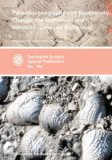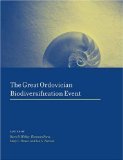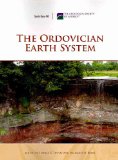Ordovician
- 1Up Info Ordovician period (Geology And Oceanography) - Encyclopedia
- A proposed Global Boundary Stratotype Section and Point for the base of the Middle Ordovician Series: The Niquivil section, Precordillera of San Juan, Argentina

- A proposed GSSP for the base of Middle Ordovician Series: Huanghuachang section, Yichang, China

- Arnold I. Miller
- Ben's Ordovician Fossil Page
- Bill Heimbrock's Ordovician Paradise
- Biodiversification of Late Ordovician Hirnantia Fauna on the Upper Yangtze Platform, South China

- Biostratigraphic correlation of the Ordovician black shales in Tarim Basin and its peripheral regions

- Calibration of the Ordovician Time Scale

- Cambrian-Ordovician succession in the Ougarta Range (western Algeria, North Africa) and interference of the Late Ordovician glaciation on the development of the Lower Palaeozoic transgression on northern Gondwana

- Chitinozoans and acritarchs from the Ordovician of the Skibno 1 borehole, Pomerania, Poland: implications for stratigraphy and palaeogeography

- Climate change and the selective signature of the late Ordovician mass extinction

- Conodont dating of the Middle Ordovician breccia cap-rock limestone on Osmussaar Island, northwestern Estonia

- Darriwilian (Middle Ordovician) conodont biostratigraphy in NW Estonia

- Evenness of Cambrian-Ordovician benthic marine communities in North America

- Fossil Fauna of Upper Ordovician rocks near Cincinnati, Ohio
- Genus richness in Cambrian-Ordovician benthic marine communities in North America

- Geologic Drivers of Late Ordovician Faunal Change in Laurentia: Investigating Links between Tectonics, Speciation, and Biotic Invasions

- Geotectonic context and palynological arguments for Cambrian / Ordovician boundary in the metamorphites of Tulghes Group from East Carpathians, Romania

- Global Boundary Stratotype Section and Point (GSSP) for the base of the Hirnantian Stage (the uppermost of the Ordovician System)

- Global Stratotype Section and Point (GSSP) for the base of the Katian Stage of the Upper Ordovician Series at Black Knob Ridge, Southeastern Oklahoma, USA

- Graphic correlation of Argentine Precordillera and North American Lower/Middle Ordovician sections

- Graptoloid diversity and disparity became decoupled during the Ordovician mass extinction

- Hirnantia sagittifera (Brachiopoda) and Mucronaspis mucronata s.l. (Trilobita) in the Upper Ordovician of the East Baltic: taxonomy and distribution

- Late Ordovician-earliest Silurian palynomorphs from northern Chad and correlation with contemporaneous deposits of southeastern Libya

- Late Ordovician-Early Silurian selective extinction patterns in Laurentia and their relationship to climate change

- Late Ordovician shelly faunas from Jämtland: palaeocommunity development along the margin of the Swedish Caledonides

- Latitudinal distribution of bryozoan-rich sediments in the Ordovician

- Litho-, chrono- and conodont bio-stratigraphy of the Rauchkofel Boden Section (Upper Ordovician-Lower Devonian), Carnic Alps, Austria

- New data on the stratigraphy of the Ordovician at Pobroszyn, Holy Cross Mts., Central Poland

- Ordovician
- Ordovician Age in Kentucky
- Ordovician Fossils At The Great Beatty Mudmound, Nevada
- Ordovician Fossils In The Toquima Range, Nevada
- Ordovician Period
- Ordovician Period
- Ordovician period - Infoplease
- Ordovician Radiation
- Ordovician stratigraphy of the Kovel-1 well (Volkhov–Haljala) in the Volynia region, northwestern Ukraine

- Palaeogeographical patterns in Late Ordovician bryozoan morphology as proxies for temperature

- Principal aspects of the Ordovician biotic radiation

- Rapid recovery from the Late Ordovician mass extinction

- Relative abundance of Sepkoski's evolutionary faunas in Cambrian-Ordovician deep subtidal environments in North America

- Relative and absolute abundance of trilobites and rhynchonelliform brachiopods across the Lower/Middle Ordovician boundary, eastern Basin and Range

- Sibling echinoderm taxa on isolated Ordovician continents: Problem of center of origin

- Size change in brachiopods and trilobites of the Oslo Region during the Ordovician and during the Ordovician-Silurian transition. Evidence of Cope´s Rule and the Lilliput Effect?

- Stratigraphy and new data on tectonics of the Ordovician strata in the section at Międzygórz quarry (Eastern Holy Cross Mountains, Poland)

- Stratigraphy of the Lower Palaeozoic of the Brabant Massif, Belgium. Part II: The Middle Ordovician to lowest Silurian of the Rebecq Group

- Subcommission on Ordovician Stratigraphy
- Trilobites and biofacies in the Early–Middle Ordovician of Baltica and a brief comparison with the Yangtze Plate

- U-Pb zircon age of Ordovician magmatism in the Albera Massif (Eastern Pyrenees)

- Wisconsin Ordovician Fauna
Books about Ordovician



